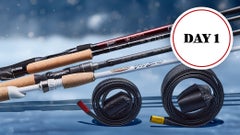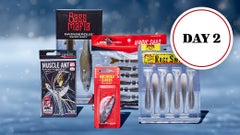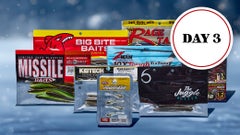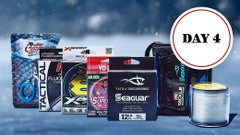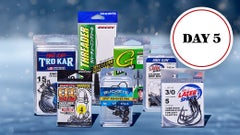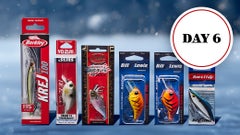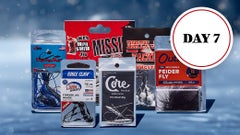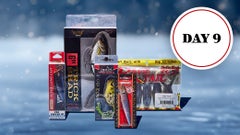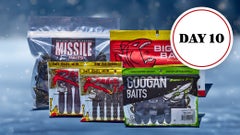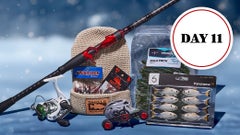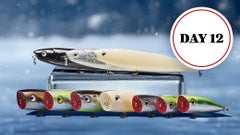Scott Martin Wins FLW Lake Cumberland
Scott Martin's Winning Patterns, Baits & Gear
Martin opened practice exploring the mid-lake region and didn't encounter a great deal of success. Later that day he had a discussion with fellow pro Matt Arey, with whom he frequently shares information. Arey relayed that he'd gotten some quality jerkbait bites on the lower end. "I'd planned to look around down there anyways, but he really keyed me in on the jerkbait thing," Martin said. "We weren't fishing the same water for the most part, but when I got down there I eventually got into a rhythm with the jerkbait and got dialed into what I needed to look for. On the second day of practice I got several nice bites, and then the same thing again on the third day." He tried a jig on the third day and the Tour co-angler who was practicing with him threw dropshots and shaky-heads. The fish showed little enthusiasm for any of those offerings. "That told me that there wasn't much of a bite on the bottom. The lake was slowly rising every day and the water temperature was falling a little bit every day. When you have that situation, it's going to make the fish suspend, so I focused on that."
Competition:
Day 1 was beset by bitterly cold temperatures, powerful winds and driving rain, but it also presented the best conditions for catching smallmouths, which are the predominant tournament species at Cumberland. There's a big catch regarding the brown fish, though - the must measure at least 18 inches to be reduced to possession, and many that the anglers connected with were just shy of that standard. Martin caught four keeper bronzebacks that day, including a 5-pounder, and capped off his stringer with a solid largemouth to put a half-pound of distance between himself and the rest of the 164-angler field. He knew that such a performance would be tough to repeat, however, was set to gradually gravitate toward chamber-of-commerce status. He caught just 12 pounds on day 2 and dropped to 5th place, almost four pounds behind new leader Clark Wendlandt. He lost a couple of good bites and caught his only two keeper smallmouths toward the end of the day. He gained back three positions in the standings on day 3, when the wind died down considerably, with a 14-14 bag that was a strong haul for the day. Missed opportunities were an issue again and he went into the final day trailing Wendlandt by 3-11. Wendlandt did the other nine day-4 qualifiers a favor by failing to catch a keeper and Martin narrowly outdueled Wilson to capture the top prize. His sack included one big smallmouth, but it was a 3-pound largemouth that he caught on his final cast with the jerkbait to replace a dinky spotted bass that may have given him his winning margin. "One of the biggest things (on day 4) was my Garmin Panoptix," he said. "I used it to see two fish come out of a sunken tree and then go back in, so I started making a bunch of casts from different angles and a 3-pounder finally bit. "If I hadn't seen that, I'd have made one or two casts on each side of the tree and then moved on. Without that fish, I wouldn't have won for sure."
Winning Pattern:
The tournament required anglers to constantly adjust in order to achieve consistency, and Martin responded to that challenge. "When the fish changed, I changed with them," he said. "There'd be little shifts in their migration based on the weather and I noticed some things that allowed me to stay on them." He said the fish he caught were all pre-spawners. They were scattered at depths from 10 to 25 feet, with some of the largemouths shallower. The most productive range was 15 to 20 feet. He made long casts with a slow-sinking jerkbait. He'd count it down to about 10 feet and then execute slow pulls with long pauses in between. He usually prefers to throw a jerkbait on 10-pound fluorocarbon line, but opted for 12-pound P-Line Tactical fluorocarbon this time. "The No. 1 thing was being efficient and keeping my rhythm going," he said. "The 12-pound Tactical is a small, thin-diameter line, but it's strong. If the bait got hung up, I could just break off the branch or tear it out of a bush and cast right back to that same spot and possibly catch a fish." He spent a good portion of day 4 throwing an old Bomber Long A wakebait that he scrounged up on a whim because he thought it suited the day's serene conditions. It produced a few good bites, including a 3-pounder that he knocked off with the rim of his net while attempting to scoop it up. He caught a couple of fish on a 1/2-ounce M-Pack Flippin' Jig on day 1. "After that cold really set in, I couldn't get bit on the bottom anymore."
Winning Gear:
Jerkbait gear: 6'8" medium-action Okuma EVX rod, Okuma TCS casting reel (6.8:1 ratio), 12-pound P-Line Tactical fluorocarbon line, unnamed jerkbait (transluscent shad).
Wakebait gear: 7' Okuma TCS Scott Martin signature series rod, same reel (8:1 ratio), 15-pound Okuma CXX monofilament line, Bomber Long A (bone).
Jig gear: 7'6" heavy-action Okuma TCS Scott Martin signature series rod, same reel (8:1), 20-pound P-Line Tactical fluorocarbon, 1/2-ounce M-Pack Flippin' Jig (green-pumpkin), unnamed chunk trailer (green-pumpkin).
Main factor in his success: "I really consolidated the area I wanted to fish."
Performance edge: "The Garmin Panoptix was so crucial, especially on day 4 when the bait showed back up in the pockets. I was able to see the clouds of bait and I could throw right to where the clouds were and catch the fish. It also told me the position of the fish each day - I'd start on the points and work my way in and every day the fish moved. As soon as I could see activity on the Panoptix, I knew that was the zone I had to focus on."
Lake Cumberland Winning Pattern BassFan 4/11/17 (John Johnson)
Barry Wilson's Winning Patterns, Baits, & Gear
Cranking gear: 6'10" medium-heavy Lew's Custom Pro rod, Lew's Custom Pro casting reel (6.8:1 ratio), 15-pound P-Line fluorocarbon line, prototype Booyah squarebill crankbait (spring craw or shad).
Bladed jig gear: Same rod, reel and line, 1/2-ounce Z-Man ChatterBait (white), YUM Pulse swimbait trailer (white).
Main factor: "Finding that place was No. 1, and then staying there and learning it and having patience with it."
Performance edge: "With my Lowrance unit, I could use my sonar to see what looked like fish, and then check and see if they were bass with the DownScan. And I always have my HydroWave on when I'm fishing - I use the 'power pattern' with the volume low and I put it on a 15-second delay. I think that made a difference."
FLW Tour Lake Cumberland 2-5 Patterns BassFan 4/13/17 (John Johnson)
Terry Bolton's Winning Patterns, Baits & Gear
Spinnerbait gear: 6'10" medium-heavy Lew's Custom Lite rod, Lew's Custom Pro casting reel (6.8:1 ratio), 20-pound Sufix monofilament line, 3/4-ounce Accent or War Eagle spinnerbait (chartreuse/white or white with silver and gold double willow-leaf blades).
Main factor in his success: "Danny told me they'd bite that spinnerbait and I had a good place to throw it."
Performance edge: "It was a combination of things, but that rod and real throws that bait so well and the feel is so good. I could cast that big bait and not have to worry about it backlashing."
FLW Tour Lake Cumberland 2-5 Patterns BassFan 4/13/17 (John Johnson)
Matt Reed's Winning Patterns, Baits & Gear
Jerkbait gear: 7' medium-action Temple Fork Outfitters rod, casting reel (6.8:1 ratio), 10-pound fluorocarbon line, SPRO McStick 110 jerkbait (blue bandit).
Main factor: "The biggest thing was not going anyplace where I'd caught one before."
Performance edge: "That rod has a real fast tip, which allowed me to snap the jerkbait real hard. I had to snap slack into the line, I couldn't get lazy with it, but I'd have to make it pause between every move. They'd bite it on the hesitation."
FLW Tour Lake Cumberland 2-5 Patterns BassFan 4/13/17 (John Johnson)
Scott Canterbury's Winning Patterns, Baits & Gear
Flipping gear: 7'6" heavy-action Halo flipping rod, Ardent Apex Grand casting reel (7:1 ratio), 20- or 25-pound P-Line fluorocarbon line, 1/2- or 5/8-ounce Dirty Jigs Scott Canterbury Flippin' Jig (the go to), Netbait Paca Chunk Sr. and other various chunk trailers (green-pumpkin).
Jerkbait gear: 7'2" medium-heavy Halo Series II rod, same real, 10-pound P-Line tactical fluorocarbon, Megabass Vision Oneten+1 jerkbait (GP pro blue or pro blue skeleton).
Main factor in his success: "The biggest thing that paid off was having a backup plan."
Performance edge: "I've got good stuff all the way around and I've got confidence in everything I've got."
FLW Tour Lake Cumberland 2-5 Patterns BassFan 4/13/17 (John Johnson)












